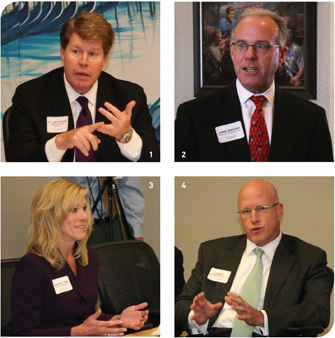
1: K.C. Matthews said multiple yield traps are thwarting investor efforts to secure higher investment returns. | 2. Historically, said Lewis Gregory, efforts to look for yield had proven to be "a disaster" for investors. | 3. Kristin Tyson said investors want asset classes that are easy to understand. | 4. Scott Boswell said the typical investor "knows how to pick the top of the market and invest at exactly the wrong time."
A silver lining that Steve Soden has spotted is investors’ increased confidence in Kansas City. “It wasn’t too many years ago that people with significant assets felt that you had to have it managed outside Kansas City,” said Soden. “That has changed dramatically. We’ve all seen a rush back home to people investors know and trust.”
Still another silver lining of the downturn, as K.C. Matthews pointed out, is that solid holding companies like UMB’s have been able to make strategic acquisitions.
Whither Yield?
Kelli Glynn asked her colleagues a question that they had undoubtedly been asking themselves, “Where do you go for yield?”
“Historically, looking for yield, chasing yield has been a disaster,” said Lewis Gregory, representing Financial Counselors, Inc. Individual investors, he observed, have a way of buying into markets “at absolutely the wrong time,” just as they are peaking. His strategy was to put his clients into investment-grade bonds in late 2008 and in 2009, and now, as the market has moved toward bonds, to put them into “equity income kinds of strategies.”
“I think what we are seeing today proves the typical investor knows how to pick the top of the market and invest at exactly the wrong time,” agreed Scott Boswell, managing director of the West Region of Commerce Trust. “The flow into bond funds has been tremendous.” Investors looking for yield have to be opportunistic but also relatively agile, he contended. They also have to have a certain tolerance for risk.
“There are incredible amounts of yield traps out there right now because investors are forced to look at some of these things to increase cash flow,” said K.C. Matthews. He recommended high dividend-paying stocks, and he believes that the energy sector is a good place to look for the same.
Adam Bold expressed a good deal of wariness about Treasuries. He, too, acknowledged that many investors “are looking for that magic bullet.” But if an investment appears to be a magic bullet, reasoned Bold, that is one good reason to be wary of it. Bold has been telling investors that they might be better off accepting a lower yield in short-term instruments, given that a year from now investors may be able to walk in at a higher rate. “A year of lower returns in exchange for not having principal losses in your fixed income portfolio might be a great strategy.”
Kristin Tyson, senior vice president of the Bank of Kansas City, observed that business owners who know and trust their industry feel more comfortable investing in themselves. In general, she surmised, “Investors want asset classes they can really understand and that are simpler and less complex.”
“We started last year putting verticals into portfolios,” said Steve Toomey. “We haven’t historically done that.” BKD is also looking outside the United States for yield and into currency movements as well. “You have to look at the entire portfolio for yield,” said Toomey. “It used to be that yield was on the fixed-income side, and that’s not the case today at all.”
As Lisa Maudlin explained, many investors are sitting on the sideline waiting for the rates to come back up. “I have a lot of people who still say ‘I just want 5 percent,’ ” said Maudlin. “Well that’s not there in the current environment.” She added, “It’s going to be a long process to get out of this downturn.”
Adam Bold regretted the infusion of all those “exotic dead instruments” into the marketplace that produced great yield for a while before taking the market down. These instruments have not necessarily gone away “You’ve got to be really wary in this market,” said Bold, “because there are still some land mines out there.”
Kelli Glynn addressed the market’s well-known pendulum swing with “fear” at one trajectory peak and “greed” at the other.